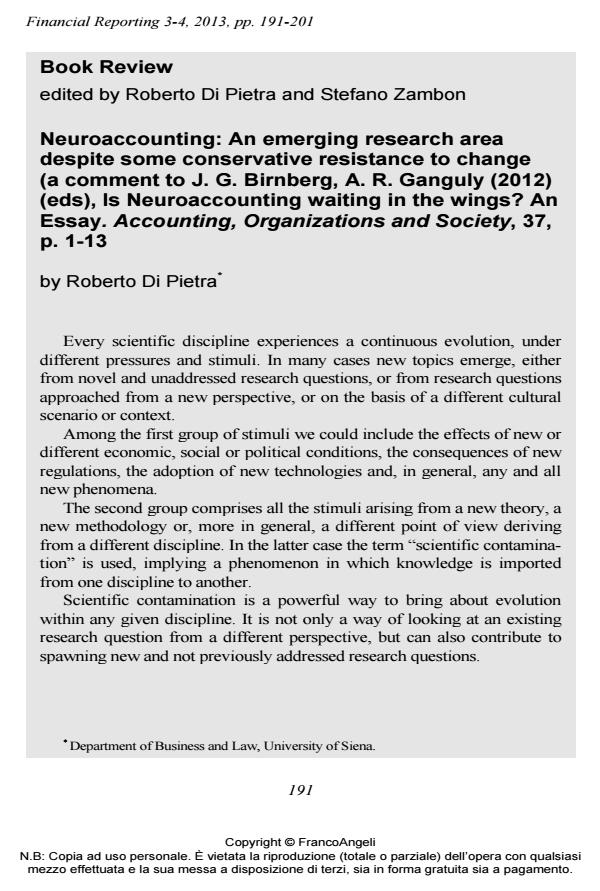Book Review
Titolo Rivista FINANCIAL REPORTING
Autori/Curatori Roberto Di Pietra
Anno di pubblicazione 2014 Fascicolo 2013/3-4
Lingua Italiano Numero pagine 11 P. 191-201 Dimensione file 157 KB
DOI 10.3280/FR2013-003009
Il DOI è il codice a barre della proprietà intellettuale: per saperne di più
clicca qui
Qui sotto puoi vedere in anteprima la prima pagina di questo articolo.
Se questo articolo ti interessa, lo puoi acquistare (e scaricare in formato pdf) seguendo le facili indicazioni per acquistare il download credit. Acquista Download Credits per scaricare questo Articolo in formato PDF

FrancoAngeli è membro della Publishers International Linking Association, Inc (PILA)associazione indipendente e non profit per facilitare (attraverso i servizi tecnologici implementati da CrossRef.org) l’accesso degli studiosi ai contenuti digitali nelle pubblicazioni professionali e scientifiche
- Basu S. (2012), How Can Accounting Researchers Become More Innovative?, Accounting Horizons, 26(4), pp. 851-870.
- Basu S., Dickhaut J., Hecht G., Towry K. and Waymire G. B. (2009), Recordkeeping alters economic history by promoting reciprocity, Proceedings of the National Academy of Sciences of the United States of America, 106(4), pp. 1009-1014.
- Basu S. and Waymire G. B. (2006), Recordkeeping and Human Evolution, Accounting Horizons, 20(3), pp. 201-229.
- Birnberg J. G. (2011), A Proposed Framework for Behavioral Accounting Research, Behavioral Research in Accounting, 23(1), pp. 1-43.
- Birnberg J. G. and Ganguly A. R. (2012), Is neuroaccounting waiting in the wings? An essay, Accounting, Organizations and Society, 37, pp. 1-13.
- Birnberg J. G., Shields M. D. (1984), The role of attention and memory in accounting decisions, Accounting, Organizations and Society, 9(3/4), pp. 365-382.
- Birnberg J. G., Shields J. F. (1989), Three decades of Behavioral Accounting Research: A search for Order, Behavioral Research in Accounting, 1, pp. 24-74.
- Brown J. (2010), “Accounting and visual cultural studies: potentialities, challenges and prospects”, Accounting, Auditing & Accountability Journal, 23(4), pp. 482-505.
- Card S. K., Mackinlay J. D. and Shneiderman B. (1999), Readings in information visualization: using vision to think. (Burlington: Morgan Kaufmann).
- Chandon P. (2002), Do we know what we look at? An eye tracking study of visual attention and memory for brands at the point of purchase, ISEAD, Working paper, Fontainebleau: INSEAD.
- Davison J., McLean C. and Warren S. (2012), “Exploring the visual in organizations and management”, Qualitative Research in Organizations and Management: An International Journal, 7(1), pp. 5-15.
- Dickhaut J. (2009), The Brain as the Original Accounting Institution, The Accounting Review, 84(6), pp. 1703-1712.
- Dickhaut J., Basu S., McCabe K. and Waymire G. (2010), Neuroaccounting: Consilience between the Biologically Evolved Brain and Culturally Evolved Accounting Principles, Accounting Horizons, 24(2), pp. 221-255.
- Dillard J. F. (1984), Cognitive science and decision-making research in accounting, Accounting, Organizations and Society, 9(3-4), pp. 343-354.
- Glimcher P. W., Camerer C. F., Fehr E. and Poldrack R. A. (eds) (2009), Neuroeconomics: Decision making and the brain: A handbook. (London: Elsevier Academic Press).
- Hartmann F. G. H., Maas V. S. (2010), Why Business Unit Controllers Create Budget Slack: Involvement in Management, Social Pressures, and Machiavellianism, Behavioral Research in Accounting, 22(2), pp. 27-49.
- Hofstedt T. R. and Kinard J. C. (1970), A Strategy for Behavioral Accounting Research, The Accounting Review, 45(1), pp. 38-54.
- Innocenti A., Rufa A. and Semmoloni J. (2010), Overconfident Behavior in Informational Cascades: An Eye-Tracking Study, Journal of Neuroscience, Psychology and Economics, 3(2), pp. 74-82.
- Lohse G. L. (1997), Consumer eye movement patterns on Yellow pages advertising, Journal of Advertising, 26(1), pp. 6-14.
- Moser D. V. (2012), Is Accounting Research Stagnant?, Accounting Horizons, 26(4), pp. 845-850.
- Pieters R. and Warlop L. (1999), Visual attention during brand choice: The impact of time pressure and task motivation, International Journal of Research in Marketing, 16, pp. 1-16.
- Reuter M. and Montag C. (2014), Studies in Neurosciences, Psychology and Behavioral Economics. (Forthcoming) (New York: Springer).
- Shneiderman B. (1996), The Eyes Have It: A task by Data Type Taxonomy for Information Visualization, Information Visualization.
Roberto Di Pietra, Book Review in "FINANCIAL REPORTING" 3-4/2013, pp 191-201, DOI: 10.3280/FR2013-003009